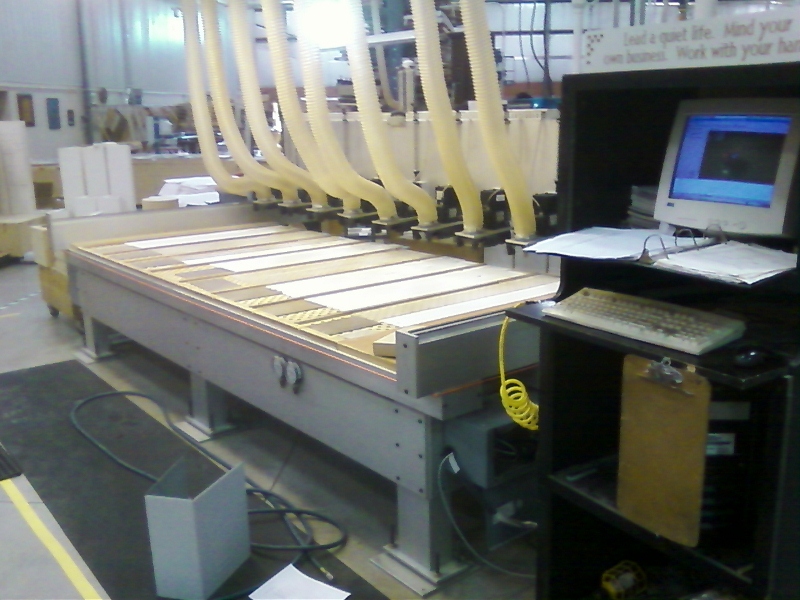First Time Help
- Todd Zuercher
-
 Topic Author
Topic Author
- Offline
- Platinum Member
-

- Posts: 5008
- Thank you received: 1441
Please Log in or Create an account to join the conversation.
- Todd Zuercher
-
 Topic Author
Topic Author
- Offline
- Platinum Member
-

- Posts: 5008
- Thank you received: 1441
Please Log in or Create an account to join the conversation.
- Todd Zuercher
-
 Topic Author
Topic Author
- Offline
- Platinum Member
-

- Posts: 5008
- Thank you received: 1441
Please Log in or Create an account to join the conversation.
The way we normally advise people to use EMC2 is to use dumb drives and bring the PID loop inside the software. You have a fairly advanced PID controller with feed-forward and programmable limits. However, the big difference is that you can use Halscope to see exactly what is going on in the software, which makes tuning easier.
Step-direction servo drives are a bodge to allow simple digital outputs like parallel ports run servos.
I think EMC2 can run that machine a lot better. However I don't think it can do it in a short timescale. If you are interested then I suggest setting up a test system and experimenting.
What motors and drives are you using?
One very simple improvement, if the drives allow it, would be to switch to quadrature input rather than step/dir. It might even help with the tuning. (through indirect effects)
EMC2 has a huge range of supported hardware. Personally I rather like the Mesa 8i20 which is a 2kW brushless servo drive that takes angle/current commands in digital form direct from EMC2.
Please Log in or Create an account to join the conversation.
- Todd Zuercher
-
 Topic Author
Topic Author
- Offline
- Platinum Member
-

- Posts: 5008
- Thank you received: 1441
Please Log in or Create an account to join the conversation.
Google is drawing a blank on that, do you have a spec?The drives are Teknic SST-1500-ALWs
There is a likely mismatch there, I suspect that the rack backlash is greater than the position resolution. Where is the feedback? If it is an encoder on the motor then that's OK. But if it is a linear encoder on the axis then the disparity will be important.It is currently set to 1000 steps/rev, on a helical rack and pinion drive (pinion is about 2" dia) with belt reduction. that ends up with about 1800 steps/inch
However, that carving looks to have problems mainly on the Z.
Please Log in or Create an account to join the conversation.
- Todd Zuercher
-
 Topic Author
Topic Author
- Offline
- Platinum Member
-

- Posts: 5008
- Thank you received: 1441
The drive is a discontinued model but its specs shouldn't be that different from the superseding models.
Here is a link to the motor specs
www.teknic.com/files/product_info/3462_V1.3.pdf
after a bit of grubbing the net here is what I could find for the drive
www.cnczone.com/forums/attachment.php?at...=114568&d=1284412755
Please Log in or Create an account to join the conversation.
www.teknic.com/files/downloads/Teknic_SS...em_Manual_Rev3.8.pdf
Indicates that the drives can be used as analogue servo drives using +/-10V signals to command velocity or torque.
However, it is not guaranteed that that would make things much better, and it would mean buying different hardware and probably quite a lot of machine downtime.
Please Log in or Create an account to join the conversation.
- Todd Zuercher
-
 Topic Author
Topic Author
- Offline
- Platinum Member
-

- Posts: 5008
- Thank you received: 1441
I think my best option is to spend some time properly tuning the drives. (time to boot back to win98 ick)
Please Log in or Create an account to join the conversation.
I am thinking of submitting the driver to the main project, and if I do that I think I would like to include a "reset" function like the parallel port has, which allows twice the step rate (it was originally called "doublestep").
The manufacturer didn't want to lend me a card to develop on (which I find disappointing)
If I do add this function, would you be willing to test it?
Please Log in or Create an account to join the conversation.




